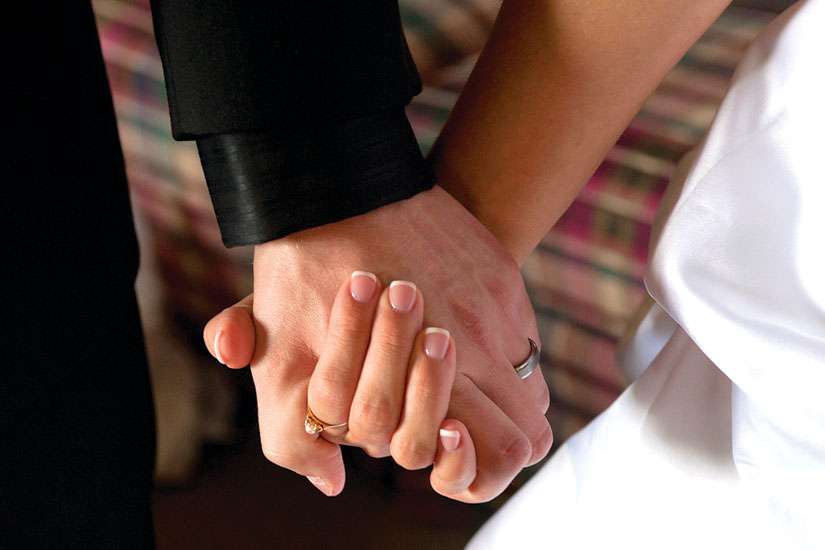He slips the ring off of his finger and hands it to me; engraved on the inner side is “true love waits.”
I was never a member of the chastity-ring bandwagon and I don’t intend to be. As much as I am stirred by young people living out holiness, I still question purity ring culture.
I wonder if chastity movements have co-opted bodies as part of an agenda that does not necessarily reflect the beliefs and traditions of the Church. I write this column in response to two stories that went viral on the Internet: “Why I waited till my wedding night to lose my virginity and wish I hadn’t” and “Christians, stop staying pure until marriage.”
The promise ring, as a cultural practice, is essentially worn when one vows to refrain from premarital sexual activity. Abstinence in these situations is good. But I think a doctrine of “waiting” has re-emerged in our vernacular because some Christians have adopted a distorted view of the goodness of our bodies.
If we can learn anything from the Gospel account of the risen Jesus, who still bears His wounds and scars, it is this: our bodies matter. If the Word became incarnate then our flesh is good. Our bodies are not separate from us. They are not empty shells. We are not divorced from our bodily experiences — that is why our parents teach us not to touch hot stoves.
I can’t believe we are still having this conversation but, somehow, purity ring culture informs the lives of many people today. This culture can impede dialogue between ring wearers and non-ring wearers as they are split into polarized camps: one that resents Christianity and embraces the body and one that seeks to overly moralize their faith.
Unmarried couples are called to abstain from sexual intimacy. But one of my concerns with Christians who parade abstinence is that they risk trivializing the goodness of the body and human sexuality.
St. John Paul’s Theology of the Body teaches that sexuality is an important part of our created body.
But purity rings can represent piety masquerading as orthodoxy and send the message that Christians do not acknowledge the goodness of sex even within the sanctity of marriage.
Those who wear purity rings are skirting with aspects of the ancient religious practice of Gnosticism. On a cool autumn evening a few years ago, my first year Bible-study group started a reading circle around a book entitled I Kissed Dating Goodbye by Joshua Harris. The title alone evoked an image of someone finding inner strength to refute societal pressures; this is essentially an aspect of Gnosticism.
As a religious studies student, I’ve learned that Gnosticism was an ancient religion that stressed dualism, especially the intrinsic tension between the body and the spirit. Celibacy was integral to Gnosticism because sex was understood as a sinful form of gratification and the body needed to be tamed. Some Christian religions might have inherited a warped understanding of sex because of Gnostic teachings.
Promise rings can impede development of a holistic understanding of the body because they reinforce a dichotomy between the evil body and the sexual person. Even though promise rings point towards potential healthy sexual relationships in marriage, in the short term they can cause the wearer to develop an unhealthy understanding of human sexuality as St. John Paul wrote about in Theology of the Body.
Abstinence is a component of chastity, but the two are not synonymous. God created the world, including sex, and He deemed creation very good. So it is wrong to encourage a notion that sex in itself is sinful, as the Gnostics believed and as purity rings seem to endorse, and instead encourage a fuller understanding of the beauty of human sexuality that is lived in marriage.
The struggle to be more God-like is the bedrock of Christian marriage. Early Christians and the Orthodox Church today identify the Greek term theosis, or the process of becoming Godlike, with chastity. By virtue of this imago dei, we are journeying towards holiness already. There is no need to wear a purity ring to enhance this divine promise.
As a future educator, I hope that the days of quirky gym teachers giving quasi-speeches regarding abstinence have ended. The Ministry of Education in Ontario is currently updating the sexual-education curriculum, arguing the curriculum should reflect the gender and sexual diversity of society. As the Catholic Church continues to co-exist in tandem with the secular world, Catholics should be discussing the narrative about abstinence and how it will be reflected in future dialogues.
(Robinson, 21, is a fourth-year Catholic Studies for Teachers student at King’s University College in London, Ont.)


